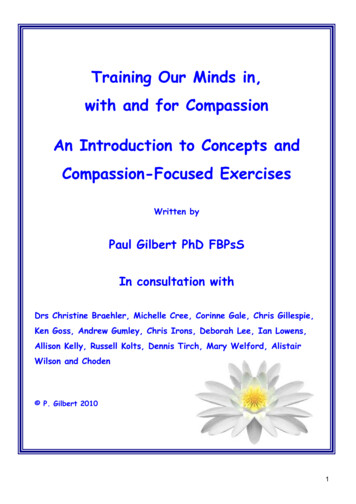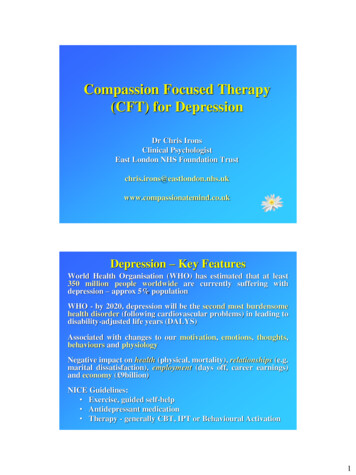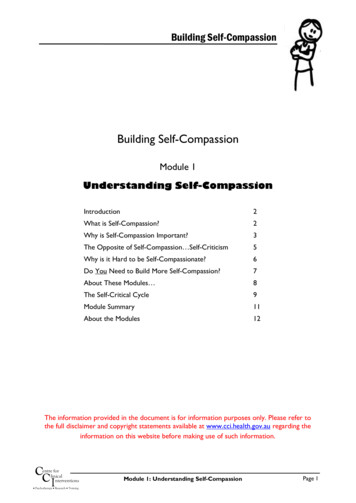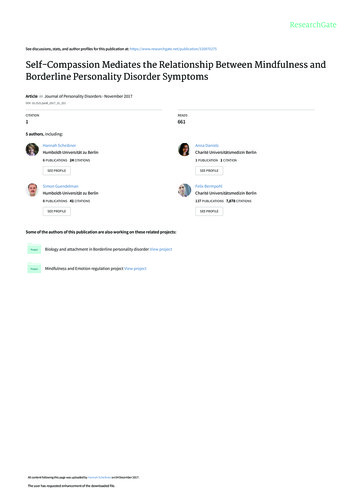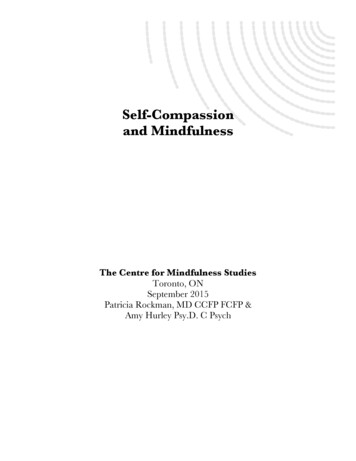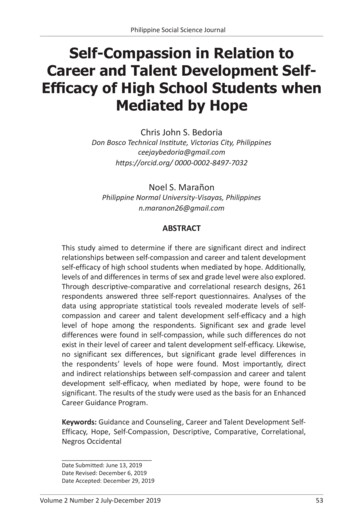
Transcription
Philippine Social Science JournalSelf-Compassion in Relation toCareer and Talent Development SelfEfficacy of High School Students whenMediated by HopeChris John S. BedoriaDon Bosco Technical Institute, Victorias City, g/ 0000-0002-8497-7032Noel S. MarañonPhilippine Normal University-Visayas, Philippinesn.maranon26@gmail.comABSTRACTThis study aimed to determine if there are significant direct and indirectrelationships between self-compassion and career and talent developmentself-efficacy of high school students when mediated by hope. Additionally,levels of and differences in terms of sex and grade level were also explored.Through descriptive-comparative and correlational research designs, 261respondents answered three self-report questionnaires. Analyses of thedata using appropriate statistical tools revealed moderate levels of selfcompassion and career and talent development self-efficacy and a highlevel of hope among the respondents. Significant sex and grade leveldifferences were found in self-compassion, while such differences do notexist in their level of career and talent development self-efficacy. Likewise,no significant sex differences, but significant grade level differences inthe respondents’ levels of hope were found. Most importantly, directand indirect relationships between self-compassion and career and talentdevelopment self-efficacy, when mediated by hope, were found to besignificant. The results of the study were used as the basis for an EnhancedCareer Guidance Program.Keywords: Guidance and Counseling, Career and Talent Development SelfEfficacy, Hope, Self-Compassion, Descriptive, Comparative, Correlational,Negros OccidentalDate Submitted: June 13, 2019Date Revised: December 6, 2019Date Accepted: December 29, 2019Volume 2 Number 2 July-December 201953
Philippine Social Science Journal1.0. IntroductionCareer development is considered as one of the fundamental aspects of humandevelopment (Yazici, 2009; Eryilmaz & Mutlu, 2017). Career development is a process,which includes all the individual’s roles before, during, and after being immersed in aparticular profession (Kuzgun, 2000). Secondary school students all over the world arefacing a dilemma in making career decisions (Macgregor, 2007; Issa & Nwalo, 2008;Watson, McMahon, Foxcroft, & Els, 2010) because there is a difficulty in reconcilingeducational requirements and career decision making (Onoyase & Onoyase, 2009). Ascareer mismatch is linked to unemployment (United Nations, 2012), several studieshighlighted the role of career guidance in schools to students’ career decision making(Ikediashi, 2010; Austin, 2010; Despina, Kostas, Argyropoulou, &Tampouri, 2012; Jamali& Kalantarkousheh, 2015).In the Southeast Asia Region, efforts are exerted to address the issues incareer decision making by conducting researches to strengthen the school-based careerguidance programs. Yuen, Gysbers, Chan, Lau, and Shea (2010) gave birth to a new termin career guidance: the career and talent development self-efficacy, which denotesa positive approach to helping students realize their skills and talents which will beneeded in their future career field. In a separate study, Yuen et al. (2006) emphasizedthat to achieve autonomy in learning, students should be confident in their own abilities,which reflects their beliefs concerning their self-efficacy (Gainor, 2006).On the other hand, self-compassion, which speaks about our dialogue withourselves (Manusov, 2011), was found to increase one’s self-efficacy (Iskender, 2009;de Souza & Hutz, 2009). Similarly, the use of hope, which speaks about our perceivedcapability to attain significant life goals (Snyder, 2000), was found to increase self-efficacyin the areas of academic, career, and occupational domains, respectively (Feldman &Kubota, 2015; In, 2016; Hirschi, 2014). The present study, however, used hope as amediator to give clarity on the results of the only published online local study to date(Nalipay & Alfonso, 2018). Results of the study found no significant direct relationshipbetween self-compassion and career and talent development self-efficacy of collegestudents, but a significant indirect relationship between the two constructs was foundusing hope as a mediating variable.The green light to pursue this study is first, the dearth in the literatureconcerning this topic. Second, the eagerness of the researcher to incorporatepsychological constructs in the career guidance program, as conventionally, resultsfrom standardized testing are used to aid career counseling, and third, no study wasfound trying to understand how these constructs operate in high school students. Thisstudy hopes to pave the way for enhancing the existing career guidance program ofa private catholic school in Negros Occidental to help better the students in makinginformed career decisions.2.0. Framework of the StudyAs theoretical support for the present study, a relatively new career developmenttheory was used. The tenets of this theory incorporate the interrelationships amongconstructs under investigation. Social Cognitive Career Theory (SCCT), which was developedby Lent, Brown, and Hackett (1994), was based on the general social cognitive theory of54Volume 2 Number 2 July-December 2019
Philippine Social Science JournalAlbert Bandura, who also happens to be the proponent of the concept of self-efficacy. Thistheory aimed to explain the three interrelated aspects of career development, namely: (1)how basic academic and career interests develop, (2) how educational and career choicesare made, and (3) how academic and career success is obtained. Additionally, there arethree variables that serve as the building blocks of social cognitive career theory – theseare self-efficacy beliefs, outcome expectations, and goals.Self-efficacy beliefs pertain to personal performance accomplishments,vicarious experiences, social persuasion, and physiological and emotional states.Outcome expectations are one’s conception of the consequences of his actions orinvolvement in an activity. Personal goals, on the other hand, are one’s intentions toengage in an activity.In 2013, Brown, Lamp, Telander, and Hacker expanded SCCT by integrating theconcept of vocational hope in the model. The inclusion of hope in the model was alsobecause of empirical support from different researches (Lent et al., 2005, Lent, Singley,Sheu, Schmidt, & Schmidt, 2007; Brown et al., 2008; Duffy & Lent, 2009; Brown, Lent,Telander, & Tramayne, 2011). The basis of choosing vocational hope as an accessoryto the theoretical model is also because vocational hope relates to other constructsinvolved in vocational psychology.Furthermore, a study conducted by Williams (2018) exhibited the integrationof mindful self-compassion and SCCT to promote self-sufficiency among adult femalesurvivors of domestic violence, telling us that self-compassion also has a link with SCCT.The theory which found its way to relate the three variables under investigationthrough several kinds of research has been supported by literature deducing therelationships between these constructs. To name a few, Terry, Leary, and Mehta (2013)found out that students with higher self-compassion are more successful in dealingwith difficulties, and are more satisfied with their decision to pursue higher educationin the university. Smeets, Neff, Alberts, and Peters (2014) found out that increaseself-compassion among college students is related to mindfulness, optimism, andself-efficacy. A research conducted by de Souza and Hutz (2016) also found that selfcompassion highly correlates with self-efficacy.The rationale of putting hope as the mediator was also based on carefulliterature review showing its link to self-compassion (Neff &Dahm, 2015), and selfefficacy in the area of academic (Feldman & Kubota, 2015), career (In, 2016), andoccupation (Hirschi, 2014). Hope has also been found to mediate different psychologicalconstructs effectively. The results of the study conducted by Yang, Zhang, and Kou (2016)displayed hope as a full mediator of the positive relationship between self-compassionand life satisfaction. Additionally, a study by Quan, Huang, Yu, and Liu (2016) alsoexemplifies the mediating role of hope between self-efficacy and subjective well-being.In the Philippines, a study by Nalipay and Alfonso (2018) also displayed the mediatingrole of hope as it mediates the relationship between self-compassion and career andtalent development self-efficacy.To sum it all, the present paper, in line with the Social Career Cognitive Theory,theorized that direct and indirect relationships between self-compassion and careerand talent development self-efficacy would be found to be significant, placing hope asan effective mediator.Volume 2 Number 2 July-December 201955
Philippine Social Science JournalTo further support the current theoretical foundations of the study, a modelwill be used to explain the mechanisms of these variables. Engine model of well-beingis a systems approach to understanding well-being. The constructs presently underinvestigation are constructs that constitute an individual’s well-being, such that theseconstructs are also considered part of positive psychology, which emphasizes humanstrengths. In the engine model of well-being, quality of life has been viewed as aninterplay among three variables: input, process, and outcome variables. Input variableshave two kinds of influences: exogenous and endogenous resources. Exogenousresources include environmental variables such as income and family situation.Endogenous resources, however, are personality traits that contribute to an individual’sattainment of a state of well-being.Don Bosco Technical Institute-VictoriasHigh School Students groupedaccording to sex and grade levelSelfCompasionCTDSelf-EfficacyHopeEnhanced Career GuidanceProgram3.0. MethodsThe present study used the descriptive-comparative and correlationalapproaches to measure the levels, sex and year level differences, and direct and indirectrelationships in and among Self-Compassion, Career and Talent Development SelfEfficacy, and Hope of high school students.The respondents of the study were the Junior High School and Senior HighSchool students from a private catholic school in Negros Occidental for the AcademicYear 2018-2019, of which 72% (n 188) are males, and 28% (n 73) are females.The data were gathered using three questionnaires. The Self-CompassionScale (SCS), a 26-item questionnaire and rated on a 5-point scale ranging from 1 (almostnever) to 5 (almost always), the Career and Talent Development Self-Efficacy Scale(CTD-SES), an 18-item questionnaire rated on a 6-point scale ranging from 1 (extremelynot confident) to 6 (extremely confident), and the Integrative Hope Scale (IHS), a23-item questionnaire rated on a 6-point scale ranging from 1 (strongly disagree) to6 (strongly agree). The original validation study of the Self-Compassion Scale yieldedhigh internal consistency reliability for the over-all scale (alpha 0.92), and for each sub56Volume 2 Number 2 July-December 2019
Philippine Social Science Journalscale (alpha 0.75-0.81). Likewise, Neff found a high test-retest reliability over a threeweek period of time for both the whole scale (r 0.93), as well as for the individualsubscales – Self-Kindness (r 0.88), Self-Judgment (r 0.88), Common humanity (r 0.80), Isolation (r 0.85), Mindfulness (r 0.85), and Over-identification (r 0.88).Furthermore, the original psychometric evaluation of the CTD-SES found the totalscale (r 0.78), and the sub-scales (r 0.54-0.69). Lastly, HIS is found to be stable andinternally consistent (alpha 0.92 for the over-all scale, and alpha 0.80-0.85 for the subscales). The scale’s construct validity as also established when it negatively correlated(discriminant validity) with depression (r -0.68), and positively correlated (convergentvalidity) with quality of life (r 0.57). Local reliability testing was conducted and yieldedthe following reliability coefficients: CTD-SES (r 0.87), SCS (r 0.76), and IHS (r 0.90).Permission was sought from the school principal. Informed consent was thensolicited from the respondents who are of legal age, while informed consent fromthe parents and informed assent from respondents who are under 18 years old weresecured, explaining the nature and scope of the study. Respondents were assuredof the anonymity of their identity and the confidentiality of the data they provided.Questionnaires that contained the raw responses were shredded after encoding.Descriptive and Inferential statistical tools were used to analyze the data. Todetermine the levels of self-compassion, career and talent development self-efficacy,and hope, Mean was used. Furthermore, to determine sex differences in the levelsof the aforementioned constructs, a T-test for Independent Samples was used. Todetermine grade level differences in the levels of the aforementioned constructs,Analysis of Variance (ANOVA) was used. Lastly, to determine the direct and indirectrelationship between self-compassion and career and talent development self-efficacyof high school students when mediated by hope, Pearson Product Moment Correlationand Mediation Analysis through Multiple Regression Analysis were used.4.0. Results and DiscussionLevel of Self-Compassion, Career and Talent Development Self-Efficacy, and HopeThe descriptive results showed that the level of self-compassion of respondentsmeans that respondents have a balanced intrapersonal perspective, which rendersthem capable of fostering care and concern for themselves. This also reflects a low levelof pessimism and a notable degree of optimism in dealing with their everyday life as astudent. Literature suggests that a high level of self-compassion is linked to decreasednegative affect (Neff, Kirkpatrick, & Rude, 2007), and increased positive affect andhappiness (Neff et al., 2007). Likewise, their level of career and talent developmentself-efficacy means that generally, respondents display interest in activities that coulddevelop their talents. This also signifies that they have the confidence to acquire positivework habits and values that would be essential in their career journey and appear to beinterested in exploring different career possibilities.In addition, their level of hope means that respondents have realisticperceptions of life. This also signifies that respondents can set goals and as well, ableto materialize the ways on how to achieve them. According to Kwok, Cheng, andWong (2015), individuals with higher levels of hope tend to display higher degrees ofVolume 2 Number 2 July-December 201957
career possibilities.In addition, their level of hope means that respondents have realisticperceptions of life. This also signifies that respondents can set goals and as well, ableScienceJournalto materialize the ways onPhilippinehow to Socialachievethem.According to Kwok, Cheng, andWong (2015), individuals with higher levels of hope tend to display higher degrees ofmotivationin dinlife.what they have achieved in life.Table 1A. Level of Self-Compassion, Career and Talent Development Self-Efficacyand 00ModMod4.6094.612.5675.6072HighHighLevelGrade 7Grade 8Grade 9Grade 10Grade 11Grade MaleFemaleNote: CTD-SE Career and Talent Development Self-Efficacy; Int Interpretation; Mod stigatedinvestigatedthethelevelslevelsofof thethe constructsconstructs erespondentsreportedmoderatelevels levelsin allinvestigation in terms of their sub-scales. The respondents reported moderateof these sub-scales. As Neff (2003a) had conceptualized it, self-compassion is composedof three components. Evidently, in the Self-Compassion Scale, six subscales have been6incorporated to indicate that the study of self-compassion has positive and negativepoles, which represent compassionate and uncompassionate behavior: self-kindness andself-judgment, common humanity and isolation, and mindfulness and over-identification.According to Neff and Germer (2018), in trying to understand self-compassion, researchersshould note that it has “yin” and “yang” qualities, which stems from the Chinese philosophyof opposite yet interdependent qualities like male and female, and good and bad. Selfcompassion is yin in the sense that it leads toward comforting, validating, and soothing intimes of suffering. It is yang in the sense that it leads toward protecting, motivating, andproviding self-security. In trying to analyze the means of the “yin” and “yang” sub-scalesof the Self-Compassion Scale, it is directly observed that yin sub-scales (Self-Kindness,Common Humanity, and Mindfulness) have slightly higher means compared to yang subscales (Self-Judgment, Isolation, and Over-identification).Moreover, when it comes to sub-scales of the CTD-SES, the high level ofrespondents’ career exploration (as compared to two other sub-scales which remainedmoderate) could be supported by the concept of the psychological moratorium of ErikErikson, where he posited that adolescents tend to explore their roles brought aboutby identity and career confusions. This high level of career exploration doesn’t mean agood evaluation of the existing career guidance program, but an implication of greaterresponsibility on the part of the counselors to assist students in their quest for careerdecision making.58Volume 2 Number 2 July-December 2019
roles brought about by identity and career confusions. This high level of careerexploration doesn’t mean a good evaluation of the existing career guidanceprogram, but an implication of greater responsibility on the part of the counselors toPhilippineSocialSciencemaking.Journalassist students in their questfor careerdecisionTable 1B.Level of Self-Compassion, Career and Talent Development Self-Efficacy, and Hope in terms elf-Judgment2.7841.1066MCommon nt DevelopmentWork Habits and Val.Career st and ConfidenceLack of PerspectivePositive Future Or.Social Relation&Personal 4.5541.405HNote: CTD-SE Career and Talent Development Self-Efficacy; Int Interpretation; M Moderate; H High7Lastly, in terms of sub-scales of the Integrative Hope Scale, respondents tendto be future-oriented, have trust in their ability to attain their goals, and are confidentabout it, and are also satisfied with their personal relations to themselves and others.However, respondents tend to display a lack of perspective.Sex and Grade Level Differences in Self-CompassionThe inferential results showed that there is a significant sex difference in thelevels of self-compassion of high school students (p 0.05). Statistically, the presentstudy revealed that males are more self-compassionate than females. Levels of selfcompassion tend to differ among men and women assuming various gender roleorientations, which would manifest as either feminity or masculinity. For instance,the feminine gender norms of nurturance and caring may facilitate self-compassion.However, norms of self-sacrifice may lead to lower levels of self-compassion amongfeminine women, as the needs of the self may have been put into secondaryconsideration. Research showed that women who are androgynous may facilitateauthenticity and are comfortable asserting themselves (Harter, Waters, Whitesell, &Kastelic, 1998, cited in Yarnell et al., 2018). Men, on the other hand, who conformstrictly to masculine gender orientation may inhibit exhibition of vulnerable feelingsand intimacy with others, which could lead to low levels of self-compassion amongmen (Reilly, Rochlen, & Awad, 2014).Additionally, this sex difference may also be because of society’s selfsacrificing tag on women. Women always have a greater tendency to prioritizethe needs of others, which may have some impact on their ability to be selfcompassionate. Women have also been observed to practice more negative self-talkthan males (DeVore, 2013). These reasons may warrant a reasonable explanation as toVolume 2 Number 2 July-December 201959
Philippine Social Science Journalthe existence of sex differences in self-compassion. However, previous studies foundno significant sex difference in self-compassion (Iskender, 2009; Neff, Pisitsungkagarn,&Hseih, 2008; Neff & Kirkpatrick et al., 2007; Neff & Pommier, 2013; Raque-Bogdan,Ericson, Jackson, Martin, & Bryan, 2011; Maccabi, Eamoraphan, &Vapiso, 2017;Muris, Meesters, Pierik, & de Kock, 2016).Likewise, significant grade level difference was found in the respondents’ levelof self-compassion (p 0.05). Currently, there is a dearth in literature venturing on thegrade level differences in self-compassion. Studies currently available investigated agedifferences, which would not be technically appropriate to explain this significance interms of age, as respondents are homogenously between 12-19 years old. But in tryingto understand self-compassion in the light of age difference, Elkind (cited in Neff, 2003a,2009) contended that self-compassion is a challenging task for teenagers. Adolescenceis an age where an individual engages in self-evaluations concerning perceived socialstandards. In Elkind’s concept of teenage egocentrism, the mechanisms of personalfable and imaginary audience contribute largely to these self-evaluations, making anindividual magnify defects and imperfections, and heightened self-monitoring attitudes.Therefore, this phenomenon of teenage egocentrism may contribute to higher scoresin self-criticism, isolation, and over-identification. And for that reason, self-compassionis expected to be lower in adolescents, though ironically, self-compassion is whatteenagers need to stay in track amidst challenges. Post-Hoc test revealed that thedifference occurred particularly between Grades 9 and 10.Sex and Grade Level Differences in Career and Talent Development Self-EfficacyThe statistical analyses of the present study yielded no significant sex and gradelevel differences in Career and Talent Development Self-Efficacy of high school students.Results of the present study were not consistent with the findings of Yuen et al. (2010),which found significant main effects for sex and grade level. These identified significantdifferences suggest that girls are more confident than boys in the area of work habitsand values. Additionally, findings also suggest that Grade 7 students are more confidentwhen compared to Grades 8 and 9 students in the area of talent development, workhabits, and career exploration. However, a study conducted by Ogutu, Odera, andMaragia (2017) found gender to have significant influence over self-efficacy factorsabout the career decision making of students.Nevertheless, the results of the present study suggest that the respondentshave reasonable confidence in their career and talent development, although it canbe noticed that at some point, self-efficacy tends to slightly reduced as students getolder. This also highlights the thought that career and talent development for secondarystudents involves learning processes about the understanding of one’s strengths,abilities, and interests, and interacting with the world of work. Career and TalentDevelopment Self-Efficacy represents the students’ self-awareness concerning theirtalents and the necessary requisites (values and habits) in the world of work.60Volume 2 Number 2 July-December 2019
Philippine Social Science JournalSex and Grade Level Differences in HopeResults found no significant sex difference in the hope of the high schoolstudents in a private catholic school in Negros Occidental. This is consistent with thefindings of Yang, Zhang, and Kou (2016), who also found no sex differences in the levelsof hope of the adolescents. In the book of Snyder (1999), he outlined the female andmale differences in hope. According to him, males should have a higher level of hopewhen compared to females because males are supposed to possess an agentic approachto things. This made him also highlight the gender stereotype literature, which describesmen in terms of instrumental characteristics and women as being expressive and arealigned toward communal matters. However, Snyder also highlighted the results of hisstudy with both children and adults, showing no sex differences in the levels of hope.As furthered by him, what accounts to this is that both sexes are now inclined towarddoing tasks or instrumental activities. With this, he came to the conclusion that whenassessing men and women in groups concerning hopeful thinking, similarities ratherthan differences should emerge.However, the results of the study of Heaven and Ciarrochi (2008) foundsignificant sex differences in the levels of hope, such that females exhibit less hope whencompared to males. During the adolescent years, both males and females encounterdifferent gender stereotypes. With that, females have the tendency to internalize thatthey are less capable than males. Authors further explained that low levels of hopein females might render a negative impact in their adjustment to adversity and theirability to cope with the challenges of life, which can also be detrimental to their wellbeing. Chang (2003), in his study using middle-aged men and women, found significantgender differences in both agentic and pathways thinking. Women reported havingweaker pathways thinking when compared to men. This implies that, as women age,they may experience failures in the process of reaching their goals, and are less able tofind new ways on how to achieve them.Still, the present study found a significant grade level difference in the levelsof hope of the respondents. Heaven and Ciarrochi (2008) conducted a longitudinalstudy examining the trajectory of hope over the span of four years. They observedthat levels of hope tend to decrease over time, which was contrary to the findings ofthe present study. Furthermore, studies have highlighted the role of transition periodsin trying to find accounts for the changing hope among adolescents. Ciarrochi, Parker,Kahsdan, Heaven, and Barkus (2015) found that hope predicted all forms of well-beingin Grade 7 and Grade 10 Australian students, which also have the same educationalsystem (K to 12) to the Philippines. These transition periods in the educational lifeof the respondents may have accounted for this difference. Given that hope hasbeen associated with the successful pursuit of goals, this significance in the levelsof hope among the respondents means that hope in transition is associated withmore engagement, and as a result could also reflect the current status of the wellbeing of the respondents. The private catholic school has been regarded as the bestengineering preparatory high school in Negros Island. Most students, especially inhigh school, opted to enroll in this school because they wanted to become engineers,as the school offers an additional technical program.Volume 2 Number 2 July-December 201961
Philippine Social Science JournalStatistically, respondents’ means in hope tend to slightly increase as theyprogress in the educational ladder. This could mean that through the unique dualcurriculum of the school, agency, and pathways, thinking as components of hopemay have been strengthened. Generally, respondents start with Grade 7 as beingintroduced to woodworking and bench working, then proceed to civil and electricaltechnology by Grade 8, and finally concentrate on mechanical and electronicstechnology by Grades 9 and 10. With these engagements to a different engineeringrelated set of training, respondents can strengthen their motivation to attain theirgoal of becoming professionals in the field of technology someday (agency thinking).Also, this could have caused the respondents to formulate ways on how to materializetheir goals (pathways thinking).Direct and Indirect Relationship between Self-Compassion and Career and TalentDevelopment Self-Efficacy when Mediated by HopeTo analyze the interrelationships between the constructs under investigation,the present study used two layers of regression analysis. The first layer would be testingthe influence of self-compassion to hope as a precursor to the hypothesized indirectrelationship between self-compassion and career and talent development self-efficacy.The second layer would be regression analyses using self-compassion and hope aspredictors and career and talent development self-efficacy as the criterion. The secondlayer will be the test for the direct and indirect relationship between self-compassionand career and talent development self-efficacy when mediated by hope.Additionally, the relationship between hope and career and talent developmentself-efficacy will also be tested to fully affirm the mediating power of hope. To positionthem, self-compassion is used as the predictor, hope as the mediator, and career andtalent development self-efficacy as the outcome variable. A significant relationshipbetween self-compassion and hope was found (p 0.05). Looking at the statistics, 17.4%of the variance in hope is attributed to self-compassion, and vice versa (r2 .174).Accordi
Endogenous resources, however, are personality traits that contribute to an individual's attainment of a state of well-being. 3.0. Methods The present study used the descriptive-comparative and correlational approaches to measure the levels, sex and year level differences, and direct and indirect

